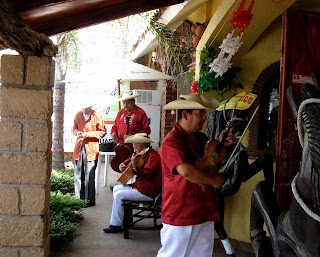It’s not often that our cravings for some international cuisine, relieving our enchilada ennui, are fulfilled by a new restaurant opening in the Pátzcuaro area. Especially a restaurant that competently prepares and nicely serves food other than comida típica.
We had hopes for the new Spanish restaurant, Rincón Español, but were very disappointed and frustrated by our recent visit there. But that is a story to be told later.
We'd been hearing good things about the new Bigoli Restaurante Italiano, in the vacated location of the ill fated steak house, Rincón Sabroso, if I recall its name correctly. It is located at the Glorieta Tangaxuan, across from Bodega Aurrerá, with the access road to the shiny new Coppel department store close by.
Since the departure of La Dolce Vita from Pátzcuaro to Morelia (there metamorphosing into Pulcinella), there had been somewhat of a vacuum for Italian food here. I've stated my personal preferences in regard to Italian restaurants before. I'll sum them up again for those of you who missed it.
I can cook Italian food quite nicely in my own kitchen. Pasta, in particular, is easy. Except for unusual or elaborate pasta dishes, I don't order it in restaurants. If pasta comes as a side to a main dish, that's fine. I might make exceptions for a good lasagna or canneloni.We met our friends Mark and Nancy at the new Coppel store and walked the few hundred feet to Bigoli. The interior has been redone and furnished attractively. We noted a sideboard was nicely setup and organized. On the negative side, the double doors entrance were wide open and let in traffic noise from the glorieta as well as chilly breezes. I put on a coat.
Our waiter was polished and experienced. He brought us a nice plate of coarsely shredded mild cheese, good sweet butter cut into neat rectangular blocks (I ate one, mistaking it for cheese), and a dish of a mildly picante, creamy tomato-chile dip. The bread was distinguished mostly by its warmth and the sesame speckled crust.
The Bruschetta topping was fine: diced fresh tomatoes, basil, olive oil and seasonings, but the barely toasted bread lacked the substance to support the topping without getting soggy. Nevertheless, we had no problem eating all of it.
The wine choices are limited, but we chose a bottle of Concha y Toro Merlot, and for Nancy, a glass of C&T Sauvignon Blanc. The Sauvignon Blanc wasn't chilled, but our waiter made an effort to chill the glass by swirling ice and water in it. He also capably knew how to serve wine at table.
We turned our attention to choosing a main course. At first I was focused on the interior menu pages, which were mostly pastas. Than one of my dining companions pointed out that the back page had meat and fish dishes. Some of the descriptions indicated a creative and imaginative chef.
- For example, Pork medallions filled with huauzontle, almond crusted, in sweet red pepper sauce.
- Baked marinated salmon in a fennel-apple sauce.
- Lomo al Jerez: pork loin "larded" with jamón serrano, sauce of sherry, Cambray onions.
- Nancy; Filet of Salmon, Mango Sauce.
- Mark; Filete de Res "Rossini".
- Doña Cuevas; Insalata "Bigoli" and a half order of spaghetti alla Bolognesa.
- Me; Filet of Tuna Palermo Style.
Descriptions and comments follow.
Nancy's Filet of Salmon was a nice portion. coated but not smothered in the mango sauce. She said approvingly that the sauce was not as sweet as some she'd had before.
 |
| Filet of Salmon, Mango Sauce |
 |
| Filete Rossini |
Her main course was a half order of Spaghetti alla Bolognesa. She let me taste it, and it was very good, too, without an excess of sauce, but lots of savory meat.
 |
| Spaghetti alla Bolognesa |
 |
| Tuna Palermo Style |
Dessert! Three desserts were offered; pastel de chocolate, tarta de peras and tarta de durazno. Mark and Nancy shared the moist, dense, fudge like chocolate cake and I had the glossy tarta de peras. The pear tart was good and I even liked the cheesecake layer between the crumb crust and the pears. It was very cold.
 |
| Tarta de Peras |
 |
| Pastel de Chocolate |
The Chef, Alberto Pozos came out to chat and we learned that he had worked for 4 1/2 years in an Italian restaurant in Puebla. His wife, who also works in the kitchen, is from Pátzcuaro. We congratulated them and wished them well.
 |
| Chef Alberto Pozos |
Ratings:
Food: ****
Service: ****
Ambience: Casual, Italian trattoria
Price: $$+ (complete meal, with wine, about $250 pesos per person)
Rest room: Old but clean. There were paper towels and soap.
Parking on side street, and for now, on the Coppel lot.
Location:
Av. Lázaro Cárdenas No. 434
Pátzcuaro, Michoacán
Tels: (434) 111-1009
(434) 342-6587
Thanks to Mark and Nancy for taking notes while in the restaurant.
Definitely worth a return visit.
There also is a limited pizza menu.
The signs on the building also say "desayunos"; something worth investigating.
What is "bigoli"? It's a thick, extruded long pasta with a central hole. It used to be made with buckwheat, but nowadays with whole wheat flour, and duck eggs. It is not on the menu at Bigoli Pátzcuaro.
More info.









































